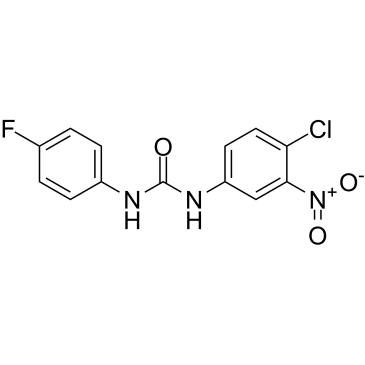Physicochemical Properties
| Molecular Formula | C13H9CLFN3O3 |
| Molecular Weight | 309.6814 |
| Exact Mass | 309.031 |
| Elemental Analysis | C, 50.42; H, 2.93; Cl, 11.45; F, 6.13; N, 13.57; O, 15.50 |
| CAS # | 897326-30-6 |
| Related CAS # | 897326-30-6 |
| PubChem CID | 108866909 |
| Appearance | Light yellow to yellow solid powder |
| Density | 1.6±0.1 g/cm3 |
| Boiling Point | 347.2±42.0 °C at 760 mmHg |
| Flash Point | 163.8±27.9 °C |
| Vapour Pressure | 0.0±0.8 mmHg at 25°C |
| Index of Refraction | 1.700 |
| LogP | 4.48 |
| Hydrogen Bond Donor Count | 2 |
| Hydrogen Bond Acceptor Count | 4 |
| Rotatable Bond Count | 2 |
| Heavy Atom Count | 21 |
| Complexity | 385 |
| Defined Atom Stereocenter Count | 0 |
| SMILES | O=C(NC1C=C([N+](=O)[O-])C(Cl)=CC=1)NC1C=CC(F)=CC=1 |
| InChi Key | DWVIOMKFHSRQQM-UHFFFAOYSA-N |
| InChi Code | InChI=1S/C13H9ClFN3O3/c14-11-6-5-10(7-12(11)18(20)21)17-13(19)16-9-3-1-8(15)2-4-9/h1-7H,(H2,16,17,19) |
| Chemical Name | 1-(4-chloro-3-nitrophenyl)-3-(4-fluorophenyl)urea |
| Synonyms | DTHIB |
| HS Tariff Code | 2934.99.9001 |
| Storage |
Powder-20°C 3 years 4°C 2 years In solvent -80°C 6 months -20°C 1 month |
| Shipping Condition | Room temperature (This product is stable at ambient temperature for a few days during ordinary shipping and time spent in Customs) |
Biological Activity
| Targets | HSF1 (Kd = 160 nM) |
| ln Vitro |
DTHIB (5 μM; 48 hours) treatment of C4-2 cells results in accumulation in the G1 phase and cell cycle arrest. C4-2 PCa cells enter senescence when DTHIB is stimulated[1]. DTHIB (0.5-5 μM; 48 hours) treatment decreases the steady-state protein abundance of the bona fide HSF1 targets molecular chaperones P23, HSP27, HSP70, and HSP90 in C4-2 cells[1]. DTHIB has an effect that is dose-dependent in reducing the clonal expansion of PC-3 and C4-2 PCa cells, with EC50 values of 3.0 μM and 1.2 μM, respectively[1]. DTHIB (0.5-10 μM) dose-dependently reduces the strong acute heat shock induction of the HSP70 and HSP25 molecular chaperones in mouse embryonic fibroblasts (MEFs). By lowering the steady-state transcript abundance of several molecular chaperones, DTHIB attenuates the heat shock response[1]. |
| ln Vivo | DTHIB treatment (5 mg/kg; intraperitoneal injection; daily; for 3 weeks) potently inhibits the growth of tumors in a C4-2 xenograft mouse model[1]. |
| Cell Assay | The HSF1 target gene expression in C4-2 Scr and shHSF1 cells treated for 36 hours with 2.5 μM DTHIB is assessed using qRT-PCR. |
| Animal Protocol |
Nude mice (6 weeks of age) injected with C4-2 cells 5 mg/kg Intraperitoneal injection; daily; for 3 weeks |
| References |
[1]. Targeting therapy-resistant prostate cancer via a direct inhibitor of the human heat shock transcription factor 1. Sci Transl Med. 2020 Dec 16;12(574):eabb5647. |
Solubility Data
| Solubility (In Vitro) |
DMSO: 86~100 mg/mL (277.7~322.9 mM) Ethanol: ~17 mg/mL (~54.9 mM) |
| Solubility (In Vivo) |
Solubility in Formulation 1: 2.08 mg/mL (6.72 mM) in 10% DMSO + 90% (20% SBE-β-CD in Saline) (add these co-solvents sequentially from left to right, and one by one), clear solution; with sonication. For example, if 1 mL of working solution is to be prepared, you can add 100 μL of 20.8 mg/mL clear DMSO stock solution to 900 μL of 20% SBE-β-CD physiological saline solution and mix evenly. Preparation of 20% SBE-β-CD in Saline (4°C,1 week): Dissolve 2 g SBE-β-CD in 10 mL saline to obtain a clear solution. (Please use freshly prepared in vivo formulations for optimal results.) |
| Preparing Stock Solutions | 1 mg | 5 mg | 10 mg | |
| 1 mM | 3.2291 mL | 16.1457 mL | 32.2914 mL | |
| 5 mM | 0.6458 mL | 3.2291 mL | 6.4583 mL | |
| 10 mM | 0.3229 mL | 1.6146 mL | 3.2291 mL |
